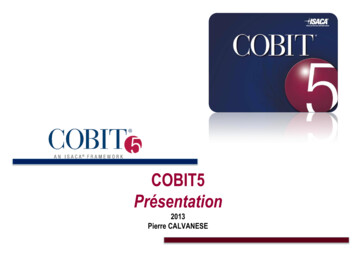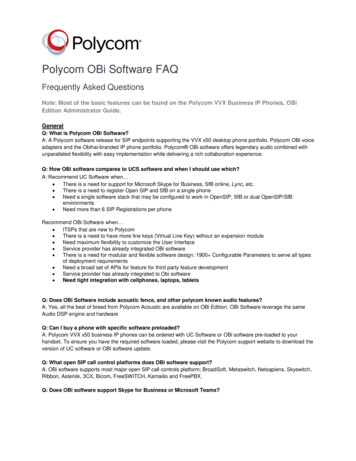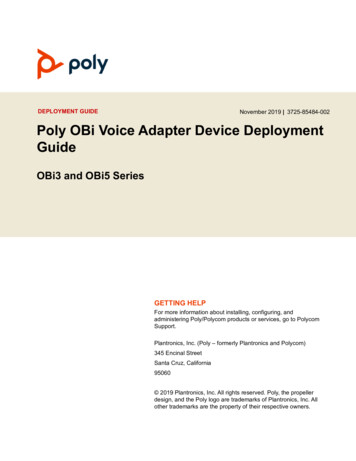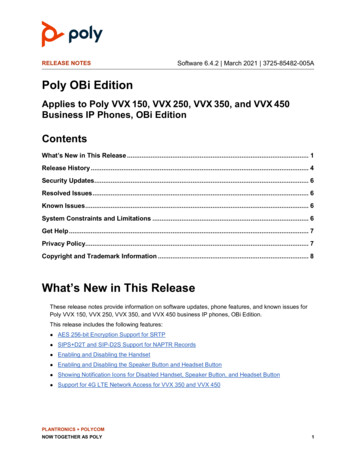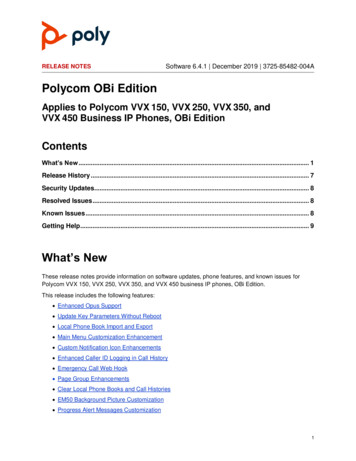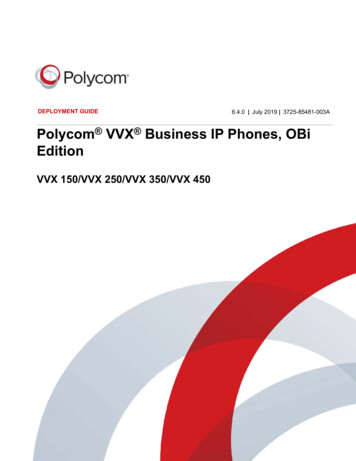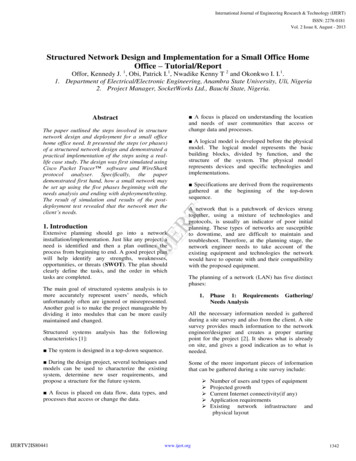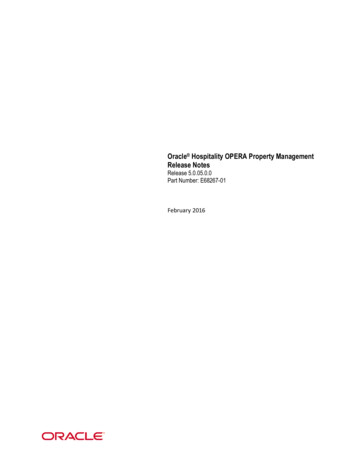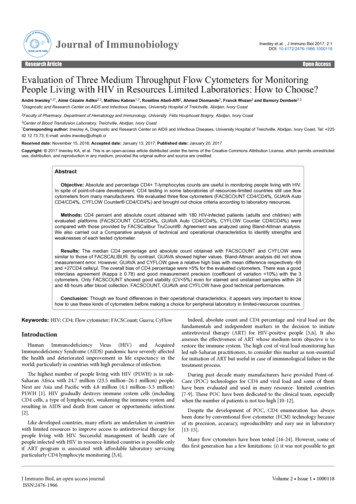
Transcription
Journylogiommunobof IalISSN 2476-1966Journal of ImmunobiologyInwoley et al. , J Immuno Biol 2017, 2:1DOI: 10.4172/2476-1966.1000118Open AccessResearch ArticleEvaluation of Three Medium Throughput Flow Cytometers for MonitoringPeople Living with HIV in Resources Limited Laboratories: How to Choose?André Inwoley1,2*, Aimé Cézaire Adiko2,3, Mathieu Kabran1,2, Roséline Aboli-Affi2, Ahmed Diomande2, Franck Wozan2 and Bamory Dembele2,31Diagnosticand Research Center on AIDS and Infectious Diseases, University Hospital of Treichville, Abidjan, Ivory Coast2Facultyof Pharmacy, Department of Hematology and Immunology, University Félix Houphouet Boigny, Abidjan, Ivory Coast3Centerof Blood Transfusion Laboratory, Treichville, Abidjan, Ivory Coastauthor: Inwoley A, Diagnostic and Research Center on AIDS and Infectious Diseases, University Hospital of Treichville, Abidjan, Ivory Coast, Tel: 225*Corresponding42 12 73 73; E-mail: andre.inwoley@ufrspb.ciReceived date: November 15, 2016; Accepted date: January 13, 2017; Published date: January 20, 2017Copyright: 2017 Inwoley KA, et al. This is an open-access article distributed under the terms of the Creative Commons Attribution License, which permits unrestricteduse, distribution, and reproduction in any medium, provided the original author and source are credited.AbstractObjective: Absolute and percentage CD4 T-lymphocytes counts are useful in monitoring people living with HIV.In spite of point-of-care development, CD4 testing in some laboratories of resources-limited countries still use flowcytometers from many manufacturers. We evaluated three flow cytometers (FACSCOUNT CD4/CD4%, GUAVA AutoCD4/CD4%, CYFLOW Counter CD4/CD4%) and brought out choice criteria according to laboratory resources.Methods: CD4 percent and absolute count obtained with 180 HIV-infected patients (adults and children) withevaluated platforms (FACSCOUNT CD4/CD4%, GUAVA Auto CD4/CD4%, CYFLOW Counter CD4/CD4%) werecompared with those provided by FACSCalibur TruCount . Agreement was analyzed using Bland-Altman analysis.We also carried out a Comparative analysis of technical and operational characteristics to identify strengths andweaknesses of each tested cytometer.Results: The median CD4 percentage and absolute count obtained with FACSCOUNT and CYFLOW weresimilar to those of FACSCALIBUR. By contrast, GUAVA showed higher values. Bland-Altman analysis did not showmeasurement error. However, GUAVA and CYFLOW gave a relative high bias with mean difference respectively -69and 27CD4 cells/μl. The overall bias of CD4 percentage were 5% for the evaluated cytometers. There was a goodinterclass agreement (Kappa 0.78) and good measurement precision (coefficient of variation 10%) with the 3cytometers. Only FACSCOUNT showed good stability (CV 5%) even for stained and unstained samples within 24and 48 hours after blood collection. FACSCOUNT, GUAVA and CYFLOW have good technical performances.Conclusion: Though we found differences in their operational characteristics, it appears very important to knowhow to use these kinds of cytometers before making a choice for peripheral laboratory in limited-resources countries.Keywords: HIV; CD4; Flow cytometer; FACSCount; Guava; CyFlowIntroductionHuman Immunodeficiency Virus (HIV) and AcquiredImmunodeficiency Syndrome (AIDS) pandemic have severely affectedthe health and deteriorated improvement in life expectancy in theworld; particularly in countries with high prevalence of infection.The highest number of people living with HIV (PLWH) is in subSaharan Africa with 24.7 million (23.5 million–26.1 million) people.Next are Asia and Pacific with 4.8 million (4.1 million–5.5 million)PLWH [1]. HIV gradually destroys immune system cells (includingCD4 cells, a type of lymphocyte), weakening the immune system andresulting in AIDS and death from cancer or opportunistic infections[2].Like developed countries, many efforts are undertaken in countrieswith limited resources to improve access to antiretroviral therapy forpeople living with HIV. Successful management of health care ofpeople infected with HIV in resource-limited countries is possible onlyif ART program is associated with affordable laboratory servicingparticularly CD4 lymphocyte monitoring [3,4].J Immuno Biol, an open access journalISSN:2476-1966Indeed, absolute count and CD4 percentage and viral load are thefundamentals and independent markers in the decision to initiateantiretroviral therapy (ART) for HIV-positive people [5,6]. It alsoassesses the effectiveness of ART whose medium-term objective is torestore the immune system. The high cost of viral load monitoring hasled sub-Saharan practitioners, to consider this marker as non-essentialfor initiation of ART but useful in case of immunological failure in thetreatment process.During past decade many manufacturers have provided Point-ofCare (POC) technologies for CD4 and viral load and some of themhave been evaluated and used in many resource- limited countries[7-9]. These POC have been dedicated to the clinical team, especiallywhen the number of patients is not too high [10-12].Despite the development of POC, CD4 enumeration has alwaysbeen done by conventional flow cytometer (FCM) technology becauseof its precision, accuracy, reproducibility and easy use in laboratory[13-15].Many flow cytometers have been tested [16-24]. However, some ofthis first generation has a few limitations: (i) it was not possible to getVolume 2 Issue 1 1000118
Citation: Inwoley A, Adiko AC, Kabran M, Aboli-Affi R, Diomande A, et al. (2017) Evaluation of Three Medium Throughput Flow Cytometers forMonitoring People Living with HIV in Resources Limited Laboratories: How to Choose?. J Immuno Biol 2: 118. doi:10.4172/2476-1966.1000118Page 2 of 8CD4 percentage which is very important in children monitoring or (ii)the use of FCM software requires good computer skills by the operator.In response to these concerns, flow cytometers manufacturers havedeveloped new technologies, already tested in some countries[14,25,26].Therefore, this study aimed at assessing these new platforms,comparing the absolute and percentage values of CD4 T-lymphocytescount obtained on these FCM with those of a reference flowCytometer, and their technical and operational characteristics.Material and MethodsBlood samplesThis study was carried out from January to October 2009. We usedone hundred and eighty (180) tubes of blood collected from HIVpositive adults and paediatrics patients, aging from 9 months to 67years. Blood samples were the remaining routine specimens kept atroom temperature and drawn within 8 h. Specimen have been selectedfrom three centers (96 from the General Hospital of Koumassi, 89General Hospital of Port-Bouet and 18 from the Pediatrics Service ofthe University Hospital of Treichville, Abidjan), in order to have atleast 50 subjects in each category of CDC classification: ( 200cells/mm3, 200 CD4 500 cells/mm3, 500 cells/mm3) [27]. Sampleswere carried from the clinical center to the laboratory in a coolercondition with icepack to maintain temperature between 18 and 22 C.We did not include: samples which provided absolute CD4 morethan 3,000 cells/mm3 on FACSCALIBUR (Becton Dickinson, San Jose,USA) or samples untested on at least one of the 3 evaluated flowcytometers.Each patient or his legal representative signed a consent form toapprove their participation to the study after reading an informationform. As the study did not require additional phlebotomy, we only gotthe agreement of scientific committee of the Pharmacy school becausethe study was part of students’ memoires.Cytometer and platform evaluatedThe 3 evaluated cytometers were FACSCount CD4/CD4% (BectonDickinson, San Jose, USA), GUAVA Auto CD4/CD4% (Millipore USA;previously Guava Technologies, Hayward, CA, USA), Cyflow CounterCD4/CD4% (Sysmex Germany, previously Partec GmbH, Munster,Germany). Table 1 shows the main characteristics of the threeevaluated flow cytometers. FACSCalibur (Becton Dickinson, San Jose,USA) was used as reference rs of PMT222LaserConvection-cooled LaserGreen diode LaserGreen solide laserOptics parametersFSC/FL1 et FL2FSC/FL1 et FL2SSC/FL1et FL2SoftwareFACSCount CD4/3 Software Version 1.0Cytosoft 6.1CyView-1.7Software usingSimple/automatic « gating »Simple/automatic « gating »Simple/manual « gating »PanelCD4-PE/CD14-PE-Cy5/CD15 ing days required222Absolute count TechnicBeadsVolumetricVolumetricOpen SystemNoYesYesNumber of tests made for reagent (showed100100 tests)9595Incubation time (min)304515Processing time for a test (min)35-5050-6025-30CD4 resultabsolute CD4/CD4%absolute CD4/CD4%absolute CD4/CD4%Analysis modesAutomaticAutomatic or manualManualControls data archivingYesYesYesArchiving of test data100 last testsYes (no limit)125000 last testsNumber of test for one operator per day756050CD16-CD19Table 1: Technical and operational characteristics of evaluated flow cytometers.FACSCount (Becton Dickinson, San Jose, USA): It is a singleplatform Flow cytometer for CD4 T lymphocytes counting, a closedJ Immuno Biol, an open access journalISSN:2476-1966system using 2 color-monoclonal Antibodies (mAb) reagents in a twintube containing reference beads. Additional control beads are available.Volume 2 Issue 1 1000118
Citation: Inwoley A, Adiko AC, Kabran M, Aboli-Affi R, Diomande A, et al. (2017) Evaluation of Three Medium Throughput Flow Cytometersfor Monitoring People Living with HIV in Resources Limited Laboratories: How to Choose?. J Immuno Biol 2: 118. doi:10.4172/2476-1966.1000118Page 3 of 8The optical and electronic systems of FACSCount can analyze 2fluorescences in addition to Forward Scatter (FSC).Guava (Millipore, previously Guava Technologies, Hayward, CA,USA): The Guava is a single platform cytometer with a system forvolumetric enumeration of T lymphocytes CD4 in the absence ofsheath liquid and beads. The optical and electronic systems of Guavaanalyse 2 fluorescences in addition to Forward Scatter (FSC). Controlbeads Guava Check are used for daily quality control.Cyflow Counter (Sysmex Germany, previously Partec GmbH,Munster, German): The Cyflow Counter is a single platform flowcytometer equipped with a system for volumetric enumeration ofCD4 T lymphocytes in the absence of beads. The optical andelectronic systems of the Cyflow Counter could analyze bothfluorescences (orange and red) in addition to the morphologicalcharacteristics of granularity (SSC). The built-in software of the newCyflow Counter is CyView-1.7 software.FACSCalibur system (Becton Dickinson, San Jose, USA):Conventional multicolor flow cytometer for CD4 T cell countingeither in single platform using reference beads or double platform withhematology analyzer. The optical and electronic FACSCalibur systemscan analyse 3 or 4 different fluorescences in addition to cell size (FSC)and granularity (SSC).CD4 T cell measurementsAll the blood samples were tested simultaneously for CD4 countingon evaluated cytometers (Guava , Cyflow Counter , FACSCount ) andreference flow cytometer (FACSCalibur ) according to the operatingprocedures required by the manufacturers. Each sample was testedonce on each device to evaluate the performance compared toFACSCalibur cytometer.For FACSCount evaluation we used the "BD FACSCount CD4Reagents kit". In brief 50 µl of EDTA whole blood was added to theFACSCount reagent tubes containing a mixture of monoclonalantibody (CD4-PE, CD14-PECy5, CD15-PECy5) with a fluorescentdye core, sample diluents and reference beads. The samples werevortexed and incubated in the dark for 30 mn at room temperature.Then, 50 µl of fixative solution was added to each tube and both wereincubated for 5 mn in the dark at room temperature. Then sampleswere run on the FACSCount after vortexing.The built-in software dedicated to this kit (FACSCount CD4/3Software Version 1.0 06/07) was used for data analysis. The measuringrange is from 50 to 2,000 CD4/µl. CD4 T cell count was expressed inabsolute number and in percentage.For Guava evaluation, the Guava Auto CD4/CD4% kit was used. Itcontains: (i) a mixture of anti-human lymphocyte antibody (CD3/CD56/CD16/CD19) conjugated to the tandem PE-Cy5 fluorochromefor lymphocytes (NK T B) recognizing, (ii) a CD4 monoclonalantibody conjugated to phycoerythrin dye. We distributed 10 µl of theGuava Auto CD4/CD4% reagent cocktail ([CD3 CD56/CD19 CD16]-PECy5 CD4-PE) and 10 µl of the total blood weredistributed in microfuge tubes. The mixture was vortexed for 2 to 3seconds. After incubation for 30 mn at room temperature in the dark,380 µl of Lysis solution 1 X Guava were added making a total samplevolume of 400 µl. The tube was vortexed and incubated again for 15mn. The samples were finally run on Guava and CD4 T cell count wasobtained in absolute number and in percentage.J Immuno Biol, an open access journalISSN:2476-1966The analysis on the Guava flow cytometer is performed by the builtin AFTP software CytoSoft Autogating 6.1 which has an automatic andmanual gating. The flow cytometer control on the Guava was achievedwith the Guava CHECK control beads.For CD4 T-lymphocytes count on Cyflow Counter , we used theCD4% easy count reagent kit (PE/PE-Dy647) containing CD4-PE/CD45-PE-Dy647 antibody panel for this assessment. For internalquality control, count check green beads of a known concentrationwere run every day to make sure that the laser was properly alignedand the analyzer was functioning optimally. Thus, 10 µl of reagent 1(CD4-PE), 10 µl of reagent 2 (CD45-PE-Dy647) and 20 µl of the totalblood were distributed in each tubes. The samples were gently mixedand incubated for 15 minutes at room temperature in the dark andthen 800 µl dilution buffer 1 and 800 µl dilution buffers 2 were addedand finally samples were read in 10 mn on the Cyflow CyView-7software which has a complete manual gating. The results wereexpressed in percentage and absolute values of CD4 per µl.The FACSCalibur was used as predicate instrument for CD4 T cellcounting in the study by single-platform. The BD TRITEST CD3FITC/CD4-PE/CD45-PerCP kit with Trucount BD tubes (catalog nº342444) were used for CD4 count. For this, 50 µl of the whole bloodwas added into TruCount tubes containing a fixed number ofpolystyrene reference beads and 10 µl of monoclonal antibody cocktailcontaining CD3-FITC, CD4-PE and CD45-PerCP. After 15 mn ofincubation at room temperature, red blood cells were lysed by adding500 µl RBC lysing solution (Becton Dickinson). The samples were runon the FACSCalibur and the data were analysed using MultiSet Version 1.0.1 software. The Calibrate beads of Becton Dickinson wereused for voltage setting and fluorescence compensation withFACSCOMP software.We used four operators, one for each FCM in three laboratories: theGeneral Hospital of Koumassi for Guava , the General Hospital ofPort-Bouet for FACSCount and CeDReS for CyFlow andFACSCalibur . These operators have been trained by FCM suppliersand these laboratories participate to external control quality of QASI.In addition, CeDReS also participate to UK NEQAS program; witchcertifies the use of FACSCalibur as reference system.Assessment of the precision of CD4 T cell counting and agedblood stabilityFor this purpose, we selected 3 blood samples in each of the 3immunological different categories previously described.To assess the Intra-run precision of the 3 cytometers, each of the 9specimens was acquired 10 times successively and average coefficientsof variations (%CVs) were calculated. The precision was expressed asthe coefficient of variance (CV) obtained by dividing the standarddeviation (SD) of all the measurements by the mean (CV% SD 100/mean).To assess the stability of preparations (unstained or stainedsamples), 3 blood samples in each of the 3 immunological differentcategories samples were tested on the day of collection. The stainedand remaining samples were stored at 4ºC and tested again after 24 hand 48 h.Volume 2 Issue 1 1000118
Citation: Inwoley A, Adiko AC, Kabran M, Aboli-Affi R, Diomande A, et al. (2017) Evaluation of Three Medium Throughput Flow Cytometers forMonitoring People Living with HIV in Resources Limited Laboratories: How to Choose?. J Immuno Biol 2: 118.doi:10.4172/2476-1966.1000118Page 4 of 8Statistical analysisWhereas, CD4 T-cell counts values do not follow a normaldistribution according to Agostino-Pearson test; nonparametricstatistical tests were used.The agreement between an evaluated and the reference methods asproposed by Bland and Altman [28,29] was illustrated by plotting theaverage of CD4 T-lymphocytes counts from the evaluated andreference methods displayed on X; against the difference between thetwo methods shown on Y. The average difference between the twomethods, referred to as ‘‘bias’’, is marked on the graph by horizontalline and Limits of Agreement (LOA) with 95% Confidence Interval(CI) were also calculated.The kappa test, using concordance kappa coefficient permits toevaluate the accuracy of the classification of CD4 T-lymphocytes inthe different categories by the Cytometer studied from the referenceCytometer (interclass agreement). The kappa value was determinedaccording to the classification suggested by LANDIS and KOCH [30].The Coefficient of Variation (CV) was calculated and used to defineagreement between each evaluated method. The method was accurateif CV 10%.Figure 1: Comparison of the general distribution absolute count(1a) and percent (1b) of CD4 T lymphocyte values provided bydifferent cytometers on a box-plot.Figure 2 provides an agreement overview between evaluatedmethods and the FACSCalibur analysis. The Bland-Altman plotsshowed no measurement error even if Guava showed a tendency tooverestimate the absolute CD4 count compared to FACSCalibur whenCD4 values are high.To evaluate the stability of the different evaluated methods andpreparation, we calculated the relative bias. Stability was considered assatisfactory when the mean relative biases expressed in percentage isless than or equal to 10% between Day 1 and Day 0 (phlebotomy Day)and less than or equal to 15% between D0 and D2.For each sample, relative bias in percentage between the resultsobtained at Di (i 1 or 2) and the results obtained on the day of bloodsampling (D0) was equal to 100x [(Di-D0)/D0].We finally compared Performance Scores (technical andoperational) of evaluated cytometers.ResultsGlobally, we used 180 blood samples from 35 children ( 15 years)and 145 adults for the assessment. The sex-ratio of this population was0.43.During assessment with Guava , automatic gating did not give resultfor 29 samples (16.1%) and the generated message indicating that thenumber of total lymphocytes was low. The lymphocyte number of thesesamples was effectively lower than 1,000 cells/mm3. However, theresults were obtained by manual gating under the administratorprofile. Also FACSCount did not provide CD4 percentages for 10.6%of samples (19/180).The median percentage and absolute CD4 T-lymphocyte valuesobtained with FACSCount and Cy low systems were similar to thoseof FACSCalibur (Figure 1). By contrast, Guava gave higher values incomparison to reference cytometer.For the absolute CD4 count, Guava and Cyflow gave a relativehigh bias with respectively -69 and 27 CD4 cell per µl. The bias of CD4percentage was relatively low and less than 2% for the 3 cytometers onthe whole and in each CD4 strata. But Cyflow gave a mean bias of 3%for CD4 percentage greater than 15%.J Immuno Biol, an open access journalISSN:2476-1966Figure 2: Bland-Altman bias plots of the difference betweenFACSCount, Guava, Cyfloe Counter systems and reference system,FACSCalibur for CD4 absolute count (a,b,c) and (percent d,e,f).Interclass agreement of absolute values was good with Guava (kappa 0.78) and very good with Cyflow (kappa 0.83) andFACSCount (kappa 0.88). Compared to FACSCalibur , thepercentage of correctly classified subjects was 91% for theFACSCount , 82% for the Guava and 86% for the Cyflow . Overall, theinter-class agreement of CD4 percentage was very good with the 3evaluated flow cytometers (kappa 0.80) and the percentage of subjectsproperly classified was 88%, 91% and 86% respectively forFACSCount , Guava and Cyflow .The results of the precision study of the three evaluated cytometersare reported in Table 2. The Coefficient variation was good (below10%) for GUAVA and Cyflow and very good (below 5%) forFACSCount . The blood stability study results are shown in Table 3.Volume 2 Issue 1 1000118
Citation: Inwoley A, Adiko AC, Kabran M, Aboli-Affi R, Diomande A, et al. (2017) Evaluation of Three Medium Throughput Flow Cytometersfor Monitoring People Living with HIV in Resources Limited Laboratories: How to Choose?. J Immuno Biol 2: 118. doi:10.4172/2476-1966.1000118Page 5 of 8For FACSCount , stained and unstained preparation was stable 24 and48 h after blood collection (mean relative bias below 5%) both for CD4absolute count and percentages.CV (%)T-CD4 CategoryAbsolute valuePercentageFACSCountGuavaCyflow 2003.989.254.9(200-500)4.195.366.9 5004.064.118.98 151.616.073.29(15-25)2.585.382.08 251.412.283.13Table 2: Coefficients of Variation (CV) of the precision study of the evaluated flow cytometersMean relative bias (%)SamplesDaysAbsolute T-CD4 Percent T-CD4 64.60-4.971.709.482.14Stained samplesUnstainedsamplesTable 3: Stability of samples with evaluated flow cytometersThe stability of stained samples was unsatisfactory with Cyflow forCD4 percentages at 24 h and 48 h. For Guava , samples were not stableonly at 48 h for CD4 absolute count and percentage.The stability of unlabelled samples was satisfactory for Cyflow (biasbelow 10% for D1 and D2) for both CD4 absolute count andpercentage. This stability was unsatisfactory for Guava early for CD4count at 24 h.Technical and operational performances score of the 3 evaluatedcytometers were compared in Table 4.DiscussionSince the introduction of Antiretroviral Therapy (ART) indeveloping countries, the need for alternative technologies of CD4 Tlymphocytes count has significantly increased. Many simplified andaffordable flow cytometers have been produced and manufacturersregularly brought innovations to address some concerns on theirtechnical performances and operational characteristics.In this study, we assessed and compared the CD4 absolute countand percentages of three flow cytometers platforms; FACSCount CD4/CD4%, Guava Auto CD4/CD4% and Cyflow Counter CD4/CD4% .Technical performancesThe Comparison of CD4 T-cell absolute and percentage values ofthe 3 evaluated flow cytometers with those obtained by FACSCalibur J Immuno Biol, an open access journalISSN:2476-1966showed that results provided by the 3 flow cytometers are similar toFACSCalibur results.The agreement between FACSCount and FACSCalibur wassatisfactory as shown by no anomaly in Bland Altman graph and goodinter-class agreement for CD4 absolute count and percentage.FACSCount had a very satisfactory precision for absolute andpercentage values with coefficients of variations less than 5%.In our context where incidents can occur on sites (power shutdown,delayed delivery of samples or equipment breakdown), it’s important tostudy the stability of the preparation. Our results showed thatFACSCount provided satisfactory results even if stained preparationsare kept for 24 h and 48 h with bias lower than 5%. The sameperformance was obtained for the sample stability. Delaying the CD4test might be an exception to solve problems but priority will be givento the resolution of the incident.For Guava, the Bland Altman agreement graph shows tendency tooverestimate the absolute results when the values of CD4 increase. Inaddition, absolute bias increases between Guava and FACSCalibur from low to higher strata. Our results confirmed previous studiesreporting that Guava is less accurate at CD4 counts above 500 cells/μl[16,20,21,31]. This difference could be caused by the way of separatingmonocyte and lymphocyte count which share CD4 on cell surface.Even all the three FCM evaluated used “lymphogating” it’s not thesame strategy. Guava used CD3/CD56/CD16/CD19 while Cyflow and FACSCount used respectively CD45 and CD14/CD15/Anti DNA.Volume 2 Issue 1 1000118
Citation: Inwoley A, Adiko AC, Kabran M, Aboli-Affi R, Diomande A, et al. (2017) Evaluation of Three Medium Throughput Flow Cytometers forMonitoring People Living with HIV in Resources Limited Laboratories: How to Choose?. J Immuno Biol 2: 118. doi:10.4172/2476-1966.1000118Page 6 of 224202224000202224022123224213123 0.90 (1)Correlation0.90-0.94 (2)0.95-1 (3) 0.60 (1)Interclass Agreement0.6-0.80 (2)0.81-1 (3) 10% (0)TECHNICALS PERFORMANCESPrecision5-10% (1) 5% (2) 10% (0)Preparation Stability 24h5-10% (1) 5% (2) 10% (0)Preparation Stability 48h5-10% (1) 5% (2) 10% (0)Sample Stability 24h5-10% (1) 5% (2) 10% (0)Sample Stability 48h5-10% (1) 5% (2)SUBTOTAL/32Limited (1)Results archivingUnlimited (2) 5 (1)Number of stepOPERATIONALS PERFORMANCES32 5 (2)No (0)AutogatingYes (1)No (0)Reanalysis possibilityYes (1)2225112222222211111100001111 100% (1)Results providing100% after re-analysis (2)314224224100% without re-analysis (3)Robustness against electricalvariationNo (0)Yes (1)1SUBTOTAL/13TOTAL/4510011101110423335Table 4: Scores of technical and operational performances of evaluated flow cytometers.J Immuno Biol, an open access journalISSN:2476-1966Volume 2 Issue 1 1000118
Citation: Inwoley A, Adiko AC, Kabran M, Aboli-Affi R, Diomande A, et al. (2017) Evaluation of Three Medium Throughput Flow Cytometers forMonitoring People Living with HIV in Resources Limited Laboratories: How to Choose?. J Immuno Biol 2: 118. doi:10.4172/2476-1966.1000118Page 7 of 8Interclass agreement between Guava and FACSCalibur was good forCD4 absolute count (Kappa 0.78) and CD4 percent (Kappa 0.88).However, only 82% and 91% of patients were well classified by theGuava respectively for CD4 absolute count and CD4 percent. EvenGuava precision was satisfactory (CV 10%), the stability studyshowed that stained preparations kept for 48 h cannot be used todetermine CD4 values. Thus, sample must be stained the day ofphlebotomy since it cannot be stored.There was a good agreement between Cyflow and FACSCalibur asshown by Bland Altman graphs. In addition, the means bias was lowerthan 30 CD4/μl for absolute values and lower than 2% for CD4%. Ourfindings are similar to those reported by Manasa et al. who also founda satisfactory agreement with a mean bias of -18 cell/µl [32]. Theinterclass agreement between Cyflow and FACSCalibur was verygood for both absolute count (K 0.83) and percentage (K 0.81), whichmeans that Cyflow could fairly classify patients in the same categorieslike FACSCalibur .Cyflow showed satisfactory accuracy in all categories for CD4percentage and absolute count, even for CD4 200 cells/μl, precisionwas less good.With Cyflow , the preparation stability was good with unlabelledsamples. This result shows that in case of incident or delayed deliveryof samples, preparations labelled can be made from samples stored upto 48 h. However, the labelled preparations are not stable and do nothave to be used despite the manufacturer's recommendations.Operational characteristicsThe operational score of the 3 evaluated flow cytometers are not toodifferent. They have many similarities but also some notabledifferences. FACSCount is a closed system using fully automatedsoftware. The software of the new platform of Guava also provides anautomatic gating with the possibility to return to administrator profileto (i) refine the results when it does not give them in automatic modeor (ii) to reanalyse data acquired to get good results. However, thegating of the Cyflow is totally manual; requiring expertise in flowcytometry and computer science.The number of samples that could be run per day is different foreach evaluated cytometer but is sufficient for the operation of the sitesto receive these equipments. More tests could be done withFACSCount . This information is useful for the choice of a cytometerwhen there is only one operator per day.The Unit packaging of the FACSCount reagent and automaticpipetting allows to achieve the optimal number of the test in thereagent kit. Guava and Cyflow do not have unit packaging of reagentper test, we noticed losses of 5 to 10% of reagent; which led to anincrease in reagent supply.Guava didn’t provide 16% of results in automatic mode for samplewith low total lymphocyte count. FACSCount didn’t provide CD4percent for 19 patients (10.5%). These difficulties could be cause by theautomatic software of these cytometers which must be improved bymanufacturers.ConclusionThe Evaluation of three platforms of flow cytometers FACSCountCD4/CD4% , Guava Auto CD4/CD4% and Cyflow Counter CD4/CD4% allowed to validate them in resource-limited settings. All theseflow cytometers showed satisfactory performances but some technicaland operational deficiencies. To choose a cytometer for a laboratory,preferences may be based on comparison between benefits and limitsrelated to: the stability of the power supply, referral specimenmanagement, delay of samples analysis, training of the operator andnumber of samples to process per day.AcknowledgementsThis article was proofread by Professor Luc KESTENS of theInstitute of Tropical Medicine, Antwerpen.References1.2.3.4.5.6.7.8.9.FACSCount must increase his results archiving as it is limited to the100 latest results and thermal paper print used degrades over time. OnCyflow , there is no possibility to store reanalysed data. Therefore, tor
FACSCalibur system (Becton Dickinson, San Jose, USA): Conventional multicolor flow cytometer for CD4 T cell counting either in single platform using reference beads or double platform with hematology analyzer. The optical and electronic FACSCalibur systems can analyse 3 or 4 different fluorescences in addition to cell size (FSC)
